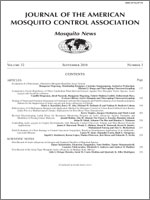A novel noncontact repellency assay system (NCRAS) was designed and evaluated as a possible alternative method for testing compounds that repel or inhibit mosquitoes from blood feeding. Deet and Aedes aegypti were used in a controlled laboratory setting. Using 2 study designs, a highly significant difference were seen between deet-treated and untreated skin placed behind the protective screens, indicating that deet was detected and was acting as a deterrence to mosquito landing and probing behavior. However, a 2nd study showed significant differences between protected (behind a metal screen barrier) and unprotected (exposed) deet-treated forearms, indicating the screen mesh might restrict the detection of deet and thus influences landing/biting response. These findings indicate the prototype NCRAS shows good promise but requires further evaluation and possible modification in design and testing protocol to achieve more desirable operational attributes in comparison with direct skin-contact repellency mosquito assays.
How to translate text using browser tools
1 September 2016
Evaluation of a Noncontact, Alternative Mosquito Repellent Assay System
Rungarun Tisgratog,
Monthathip Kongmee,
Unchalee Sanguanpong,
Atchariya Prabaripai,
Michael J. Bangs,
Theeraphap Chareonviriyaphap
ACCESS THE FULL ARTICLE
It is not available for individual sale.
This article is only available to subscribers.
It is not available for individual sale.
It is not available for individual sale.
Aedes aegypti
DEET
noncontact repellency assay system
protection time
repellency





